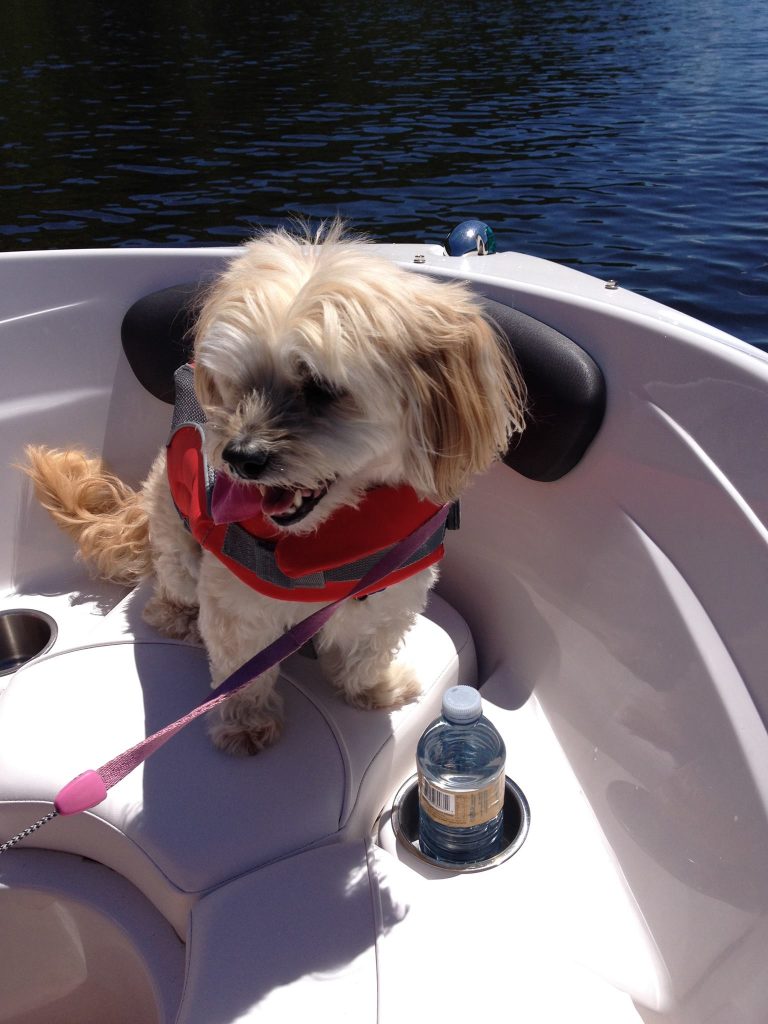10 boating safety tips for pets
by Ontario SPCA and Humane Society | General Pet Care | August 1, 2022

If you’re heading out on the water this summer and are planning to bring your dog along, there are some key safety tips you need to remember.
10 tips to keep your pets safe while boating
Introduction to swimming: Before bringing your dog on a boat it is recommended that you introduce them to the water first. Never force your dog to go in the water or throw them in as it can be very frightening; keep the experience positive by letting them explore at their own pace.
Keep in mind breed can make a big difference in your dog’s affinity to water. Dogs with flat noses, such as Bulldogs, or those with particularly short legs, such as Dachshunds, are not adapted to be avid swimmers. Comparatively, some breeds such as Retrievers and Pointers have webbed feet and elongated snouts that make them keen swimmers. You should be aware of your dog’s swimming capabilities prior to boating with them.
Introduction to the boat: Allow your dog time to become familiar with the boat before going on any long trip. Short trips can help your dog have a positive experience and help prepare them for longer trips. This will also give you time to assess if your dog gets sick while onboard.
Invest in a life jacket: Even good swimmers can tire easily in rough water, particularly if you’re far from shore and if the water is cold. Even if you’re near shore, the shoreline may be slippery or too steep to climb up. Life jackets not only keep your pet afloat if they decide to “jump ship” or fall overboard, they can also help protect against hypothermia in cold water and can also make it easier to pull your dog back onboard.
Make shade available: Remember it can get very hot on a boat. Be sure to provide a shaded area for your pet to rest. Also have lots of water accessible to prevent dehydration and/or heat stroke.
Keep comfort in mind: Does your dog have a comfortable place to rest on the boat? Depending on the type of boat and the material on the floor, you may also need to add a non-slip surface to prevent your dog from slipping and falling.
Portable potty system: If you are planning to be on the water for a long period of time, you’ll need to plan stops where you can disembark with your dog. Alternatively, if you are going to be out for long periods where there is nowhere to dock, you may need to bring a portable potty system (a square piece of turf may work for some dogs or look up “pets and portable potty system” on the internet).
Make a plan if your pet goes overboard: Talk with your family or friends in advance about what you will do if your pet falls overboard. Having a plan will make the rescue smooth and easy in the moment.
Leash/Harness: Bring along a leash and harness so you can safely disembark with your dog during rest stops. A harness also provides an easier means to lift your dog out of the water if they fall in.
- Pet first aid kit: In case of emergencies, bring along a pet first aid kit. It’s also a good idea to find out where the closest veterinarian is to where you’re boating in case anything happens to your pet.
Finding your dog a life vest:
Even the most skilled swimmers (both humans and dogs!) require the aid of a life vest to keep them safe when out on the open water. Depending on the size and breed of your dog, you can purchase a life vest that provides the ideal support for your pet. Here are some things to consider:
- Size and weight capacity: Every brand will have measurements and weight ranges associated with the ideal sized dog it can fit. If necessary, take your dog’s measurements (including the chest circumference and torso length). The fit should be snug, but still allow the dog to move comfortably.
- Buoyancy: Life vests can be made to have floatation support in various locations surrounding your dog, including the side, back and belly, with some that have floatation support under the neck to assist in keeping the dog’s head above the water.
- Attachments: Vests will have distinctively placed easy-access clips for leashes to be attached, and/or handles for owners to be able to pick the dog up easily should they fall overboard.
- Colour: Vests come in all different colours and patterns. Most are bright and some even have reflective components to increase the visibly of your dog. If you are boating at night, it may be a good idea to purchase a light attachment that can be placed on the vest or collar of the dog.
Remember, boating should be fun for everyone – including your dog. If they are afraid or are not enjoying the experience, leave them at home where they are safe and comfortable.
Categories
Testimonial
Thank you for your dedication
Thank you for your dedication to helping the animals. Every animal deserves a loving home and to be treated royally. Just imagine a day without animal cruelty. What a wonderful day that would be!
